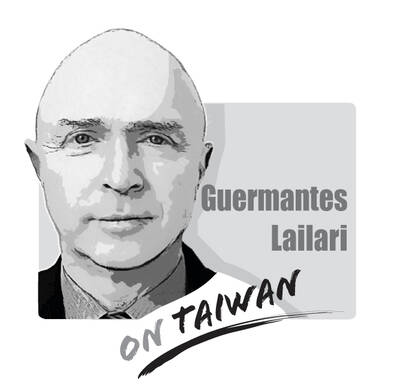While attending a committee meeting at the Legislative Yuan on Sept. 30, Minister of National Defense Yen De-fa (嚴德發) reported that since the beginning of the year, aircraft deployed by the Chinese People’s Liberation Army Air Force have entered Taiwan’s air defense identification zone 217 times.
During the same period, the air force conducted 2,972 sorties to monitor and intercept Chinese warplanes, which cost NT$25.5 billion (US$880.52 million). Yen confirmed that additional funds must be allocated to the air force’s budget for the next fiscal year to compensate for the extra flying time.
Even as the nation’s finances are precarious due to economic fallout from the COVID-19 pandemic, the cost of additional interception sorties is likely to soar to NT$30 billion. Also, front-line military personnel are becoming fatigued at a greater rate, creating a never-ending logistical nightmare.
Czech Senate President Milos Vystrcil, who last month headed a delegation to Taiwan, said before leaving the nation that he hoped for more exchanges between Taiwan and the Czech Republic.
Maintaining considerable cooperation on economics and trade would enable the two nations to continue to deepen their relations. A good place to start would be the Czech Republic’s aeronautical supply chain.
The Czech Republic is a member of the European Aerospace Cluster Partnership and Czech plane maker Aero Vodochody produces the Aero L-39 Albatros jet trainer. About 2,800 L-39s have thus far been deployed by more than 30 air forces around the world.
The company also produces an updated design, the Aero L-159 ALCA, a light attack aircraft and advanced jet trainer. The L-159 has the same Honeywell/ITEC F124 turbofan engine as Taiwan’s Indigenous Defense Fighter (IDF), except that the L-159 has a single engine. However, this reduces its overall cost, so that it is an absolute bargain compared with the IDF.
Introduced in 2000, the L-159 has been deployed by the Czech Air Force and purchased by Spain and Iraq. Venezuela and Bolivia had placed orders, but the US objected and the sales were aborted.
Taiwan has over several decades been developing the nation’s aeronautical industry, but local firms only perform subcontract work for large European and US companies. Cooperation with Czech aviation companies would be a winning strategy for both sides.
Aerospace Industrial Development Corp has begun testing its T-5 Brave Eagle advanced jet trainer. Relatively few of the T-5s would replace the air force’s Northrop F-5E/F Tiger II fleet of trainer aircraft, so it would not conflict with Czech designs.
As the T-5 is in research and development, with a while before mass production, a quicker option would be to bring in a mature, existing model. Doing so would be a “win-win” for foreign diplomacy and national defense.
The Czech government in 2015 approved the sale of 15 L-159 fighters to Iraq for US$30 million, or US$2 million per airplane. Rather than use the F-16 or Mirage 2000, which are US$40 million to US$50 million per plane, it would cost less to buy training and attack jet fighters that are less than one-10th of the cost and deploy those to intercept Chinese warplanes that approach Taiwanese airspace.
Affordable airplanes — with savings going to staff and operational costs — is a good way to reduce overall government spending and enhance diplomatic ties.
Chang Feng-lin is a university lecturer.
Translated by Edward Jones and Perry Svensson
The gutting of Voice of America (VOA) and Radio Free Asia (RFA) by US President Donald Trump’s administration poses a serious threat to the global voice of freedom, particularly for those living under authoritarian regimes such as China. The US — hailed as the model of liberal democracy — has the moral responsibility to uphold the values it champions. In undermining these institutions, the US risks diminishing its “soft power,” a pivotal pillar of its global influence. VOA Tibetan and RFA Tibetan played an enormous role in promoting the strong image of the US in and outside Tibet. On VOA Tibetan,

There is much evidence that the Chinese Communist Party (CCP) is sending soldiers from the People’s Liberation Army (PLA) to support Russia’s invasion of Ukraine — and is learning lessons for a future war against Taiwan. Until now, the CCP has claimed that they have not sent PLA personnel to support Russian aggression. On 18 April, Ukrainian President Volodymyr Zelinskiy announced that the CCP is supplying war supplies such as gunpowder, artillery, and weapons subcomponents to Russia. When Zelinskiy announced on 9 April that the Ukrainian Army had captured two Chinese nationals fighting with Russians on the front line with details
On a quiet lane in Taipei’s central Daan District (大安), an otherwise unremarkable high-rise is marked by a police guard and a tawdry A4 printout from the Ministry of Foreign Affairs indicating an “embassy area.” Keen observers would see the emblem of the Holy See, one of Taiwan’s 12 so-called “diplomatic allies.” Unlike Taipei’s other embassies and quasi-consulates, no national flag flies there, nor is there a plaque indicating what country’s embassy this is. Visitors hoping to sign a condolence book for the late Pope Francis would instead have to visit the Italian Trade Office, adjacent to Taipei 101. The death of
By now, most of Taiwan has heard Taipei Mayor Chiang Wan-an’s (蔣萬安) threats to initiate a vote of no confidence against the Cabinet. His rationale is that the Democratic Progressive Party (DPP)-led government’s investigation into alleged signature forgery in the Chinese Nationalist Party’s (KMT) recall campaign constitutes “political persecution.” I sincerely hope he goes through with it. The opposition currently holds a majority in the Legislative Yuan, so the initiation of a no-confidence motion and its passage should be entirely within reach. If Chiang truly believes that the government is overreaching, abusing its power and targeting political opponents — then